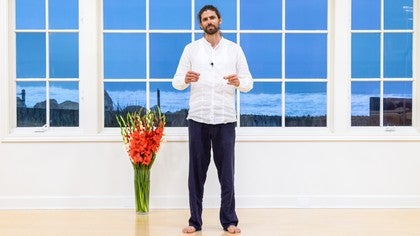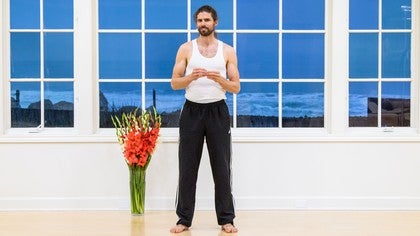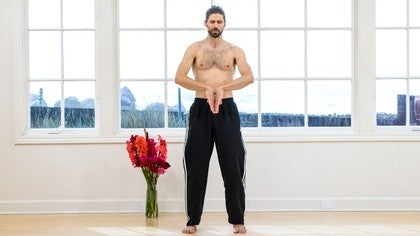Description
About This Video
Transcript
Read Full Transcript
So in this course, we've already explored some sound-based practices, or begun to explore sound-based practices, and some of the other parts that we'd like to invite you to explore are physical practices, or movement practices, or asana practices. And we've just encountered, potentially, emphasizing the importance of faith, courage, conviction. There's a teacher who has some wonderful programs that you can watch on Yoga Anytime called Eric Shiffman. And in one of his programs, he says, self-trust is the advanced practice. This is very much in accord with what Patanjali says.
It's really the prerequisite for practice. And movement practices, I feel, are a really powerful way to deepen this self-trust. However, if we engage with asana negligently, or a little bit carelessly, even with good intentions, we can erode our self-trust. Because yoga asana is part of hatta yoga, and hatta yoga is the yoga of the sun and the moon. In other words, ha standing for sun, ta standing for moon.
In other words, it's the yoga of expansion and contraction. It is a tantra in the sense of a technology that works with the innate technologies of this amazing body-born conscious vehicle to facilitate yoga. So hatta yoga techniques basically deploy the natural pulsations in our body as means to foster yoga in the sense of harming integration. So we are pulsating. We are expanding and contracting all the time with every heartbeat, with every breath cycle.
But the heart and the lungs are not the only pumps in our body. We can do other things that can influence expansion and contraction. We can move, for example. So if we lift something, for example, if we lift a leg, if I lift my right leg, and if I extend it, I'm shortening the top of my leg and lengthening the underside of the leg. Same if I do it on the opposite side.
So just by moving in a certain way, I can start to affect the flow of energy and information in my body. And this is one of the key principles that is underlying a lot of asana technique. And many aspects of hatta yoga technique. Now the classic, or what I refer to as the classic modern yoga asana, where did they come from? Hatta yoga and the foundations of yoga asana, they are said to have been gifted by Lord Shiva, the Lord of yoga himself, to human beings long ago.
Now we can understand this figuratively as well. In the sense that all the different postures, all the different ways that we can move, they are natural expressions of our conscious potential. Shiva meaning consciousness without limit. And Shiva is also known, as well as being the Lord of yoga, he's the Lord of the dance, nataraja. And in the Indian shastra, the system of nathya, which means performing arts, dance, there are the hundred and eight karanas, the hundred and eight instrumental positions of the body.
And these karanas, they show Lord Shiva in lots of different shapes. And all these different shapes, they create different flows of energy in the body and he's bending in different directions, falls and back, but also in very curved forms that are much more curved than the classic modern yoga asana forms that we might be more familiar with. And all this is to say that moving the body in different ways to facilitate the flow of energy and information in different ways, this is not something particular to yoga asana. This happens when we move. But the yoga asana systems that have become more prevalent in recent years, owing in significant part to the work of some great pioneers from India in the last couple of centuries.
I think it's worth asking the question, who codified or developed or invented or set down these forms? And if we think of India in the late 19th and early 20th century, the people who invented or codified these ways of working with asana, what type of lifestyle did they lead? And what type of human body were they working with among their students? We live now, a lot of the time, in the realm of the chair. Most of us have grown up spending significant amount of time sitting in a chair.
It was certainly the case for me. I was a very active child. I was running around at every opportunity. However, from a certain perspective, you could still say that I lived a sedentary lifestyle. Because even though when I went to school, I would run to school, I would run at the break time, I would run in the lunch time, I would play sports after school and run home, in between times, I was subjected to spending long periods confined in a chair.
And so all through my childhood and my youth, and then in my working life, in the jobs that I have done, I have had significant periods of being in one position sitting down. And what this does is it means that the body kind of starts to get used to sitting in one position. It adapts to sitting in one position. Because we, everything is training. We get good at what we do.
But if we sit in a chair a lot, the body adapts to sit in a chair. But the people who invented yogasana, chairs were almost unknown to them. They lived on the floor. And so they were used to spending a lot of time on the floor, in different forms. They might kneel on the toes.
They might kneel on the feet. They might sit in a cross-legged position. They probably sit in a cross-legged position to eat. And when you sit in a cross-legged position, the spine moves a lot, a lot, a lot more than if you sat in a chair. And from sitting on the ground, where people would do so many things before chairs, they would also live in the low gate.
Meaning they would move low to the ground. And they would walk without standing up. They would move around in the low gate. And these days, many of us, we don't do this. And so consequently, it's not so easy for us, because we don't have that range of motion in the hips.
We don't have that deep strength through the whole kinetic chain from the foot to the head. Because this is something that I've noticed living in Asia, as I've lived in Japan and in Thailand and India. And I've noticed in India, for example, you can see people who look relatively advanced in age, very scrawny, they don't look strong, and I will see them lift literally 90 kilograms, more than I weigh, significantly more than I weigh, on their head, more than they weigh. And they do it easily, without straining, they just lift it up. And they also, I've seen old ladies who look like, you know, they're in their last few years of life, get up from the ground without using their hands, easily.
But I know many people, and I was one of these people, that's not easy. I know people who can lift big weights, they might think they're very strong, but to get up from the ground without using their hands, not easy. And to get up from the ground on one foot, not easy at all. But for many people who are living a more, let's say, traditional lifestyle, a pre-chair lifestyle, they would do that many, many times in the day. And what would they do to get water?
A lot of the time, they'd go for a walk to a source, maybe a well, and then they'd take water from the well. They're getting a resistance workout without ever going to a gym. They're getting strong, lifting weights, just in the flow of life. And they're relaxed, talking to their friends while they go and collect water. So you're relaxed, your breath is easy, but you're also lifting weight, moving things around and moving your body around through many different orientations in space.
And what this means is the people who invented yoga, for them, the low-gate was natural. It was easy. And this deep squat position was very familiar to them. Every time an Indian person would go to the toilet back in the day, they would be in this position since they could, since before they could walk. And for me, I know I was unable to adopt this position for many, many years, and I still have to be careful in it.
But for many people in Asia and people living more traditional lifestyles, they're going to hang out in this position, listen to a story being told in this position, have a meal in this position. And when this position is easy and familiar, and you get up and down from the low-gate into a standing position, it cultivates this integration of the kinetic chain from the floor all the way through the spine. And so what I think is important to emphasize is that the yogas and the sequences and systems that we have become exposed to, they often take the people who invented them, they took it for granted that the people be working with these things were comfortable in the low-gate and comfortable sitting on the ground. And so it's important for us to remember that. When I lived in Thailand, and I was teaching yogasana, often at the beginning of the class we would sit on the ground, sit on the floor.
So I invite the people to sit down, and I remember many, many times people who were beginners who'd never done yogasana before, they would sit in lotus, which I cannot do, but they would not use their hands to put the legs into lotus. They just sit on the floor in lotus because they sit on the floor to eat their meals, and they just do it effortlessly. They fold the legs in lotus as easy as I fold my arms. And this is also very important, is that when we work with asana, we use the forces of the body's structure. So it's important to deploy those forces with care, with discrimination.
So in the way that we're going to share the practices in this course, I'm going to emphasize an active asana, working against gravity, and not manipulating the body with our hands, but rather moving the body where we can control the movement. And then we can start also to rehabilitate the low gate, the deep squat. And so give us a little bit of that deep structural strength that can make our work with other asana safer, and hopefully more rewarding.
Yoga Sutras of Patanjali: Yogic Movement: Don't Just Sit There!
Comments
You need to be a subscriber to post a comment.
Please Log In or Create an Account to start your free trial.











